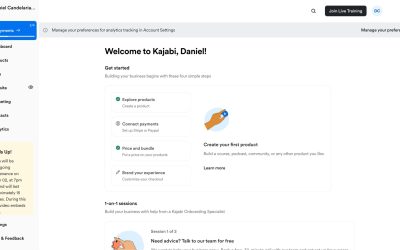It’s February 2019, and technology has found its way into more places in our lives than we could have ever imagined. In some ways, covertly, and in other ways, glaringly obvious.
It’s hard not say this without completely cheesing up this entire article, but here it is anyway: the future is here.
What does that even mean?
Well, technology, and therefore information, is integrated into every detail of our lives like never before.
There was a time in the not-so-distant past where no one had a cell phone. And then, there was a time where some people had this ridiculous thing called a car phone. And the car phone could be used as a bag phone, you know, a phone in a bag. But you could only carry it around for a little bit before you needed to get it back to the car to charge it. The home computer became more commonplace, and dial-up internet was as good as it got at the time. This is my incredibly insufficient summary of technology evolving over time.
The point is, our access to information, and to one another, ramped up at an alarming rate, yet today we take it for granted.
Along with our over-connectedness has come a new darkness: isolation like never before, despite our over-connectedness. People cling to their devices and their social media personas for dear life, constantly shaping the version of themselves that they want the world to see. The way we use the internet vastly warps our reality into something that is only partially real.
So, what does all of this mean for therapists, and where is our industry heading as it relates to the evolution of technology, information, and the internet?
Well, here’s what I see at the moment.
Just a few years ago I was running a thriving solo practice in San Francisco, one that I had marketed entirely online. No networking, no open houses, no dropping off fruit baskets at doctor’s offices. I made a website, conveyed a message, and got it in front of as many people looking for therapy as possible. I leveraged the internet to quickly build a business that just a few months prior, didn’t exist. Other therapists in San Francisco didn’t know about me yet, and it didn’t matter. Clients were opening up their web browsers to find help, and I was showing up.
Six months before I moved to Charlotte, NC I built a website using what I’d learned in San Francisco, and the first day I opened my new practice in Charlotte I had 6 clients on my calendar. Still, no therapists knew me, I had just kind of showed up and started getting clients. The therapists in my suite wanted to know how I did it.
So, the way that consumers find their next therapist has evolved in a rapid fashion. They aren’t asking their general physician quite as much. They aren’t asking their friends and family as much. They are taking matters into their own hands, and doing their own research. I’ve since made a career for myself in helping therapists be in the right place at the right time online, so that they can get Fully Booked in a way that doesn’t burn them out or take needlessly long.
I suspect that consumers will continue finding their next therapist online at an increasing rate—the same way that singles find their next partner online. In the dating world, people finding a partner offline are certainly the new minority.
What does this mean for you as a therapist trying to market your private practice? Well, it means that you need to develop a basic understanding of how the internet works, and where it’s heading.
What does this mean for clients? Well, it means that not only are they finding their therapist online, but now they want to meet with their therapist online, and in many cases, exclusively online.
This trend comes as a convenience to many therapist who are dying to build an online practice. Even in the past 6 months, I’ve met an impressive number of therapists who are trying to do exactly that. And I see the appeal. You can work from anywhere, there’s almost zero overhead, you don’t have to commute, your clients don’t have to commute, and you can live life truly on your terms.
Some therapists who are making the transition from in-person to online are simply asking their clients: “do you want to keep working together through video sessions?” And in general, many clients are agreeable. Once they see how it feels after a session or two, they seem to generally be on board to continue meeting online.
This is where the private practice and mental health industry is heading, and we’re heading there fast.
To add to the equation, internet delivery speeds are continually improving, even in rural areas and countries that are underdeveloped. If the client or therapist doesn’t own a laptop, they can easily substitute their smart phone or even a tablet. The barriers to entry are diminishing, if they haven’t already diminished.
The essence of video sessions is that it is seemingly as close to “real life” as we can get. The client and therapist are “face-to-face” on the screen, and when the therapist looks right into the camera, the client feels as if they are making near-perfect eye contact. As internet speeds increase, so does video and audio quality, which allows the therapist to better detect the subtle shifts in facial expression, tone, and body language—information that is critical to the effectiveness of therapy.
The good news is, this means that more people than ever can access skilled therapists regardless of where either party is located. And it gets better.
With the rapid evolution of virtual reality (VR) and augmented reality (AR), there is a new option arriving on the market that will allow the client and therapist to feel even closer, even more real. With each party wearing a headset like the Oculus Rift, each person will experience the other as if they are 3D, as if they could almost reach out and touch them. As additional accessories to VR headsets evolve, reaching out and touching the person on the other end also becomes a “reality.” Telemedicine is already using this technology in some extremely advanced ways, and mental health won’t be far behind.
As technology takes more of a foothold in our lives, comes ambivalence from therapists and helpers of any kind. After all, a big part of what we do is the “being with” and being present with clients that truly heals. And we want our clients to be able to connect with important people in their own lives in a way that is real, and not virtual.
I share some of that ambivalence, too, yet I love being online. Maybe it’s not as much that I love being online, as I love how being online can connect us no matter where we are. And I think we have to keep pushing to use the internet in this way—to use it for good.
I also believe the rise of the internet is too strong to resist, and those who choose not ride its wave will have more challenges than those who do.
With that being said, I see my role in helping therapists as a guide, and a guide stays just a half step ahead of those who he is leading. I don’t know everything about being online, but I know enough to help therapists navigate what’s happening online now, and what might lie ahead.
If I can be your guide, book a free strategy call now.




Love this article John Clarke!
Thanks Mary! Great to hear from you. Let us know what other kinds of content you’d like to see next!